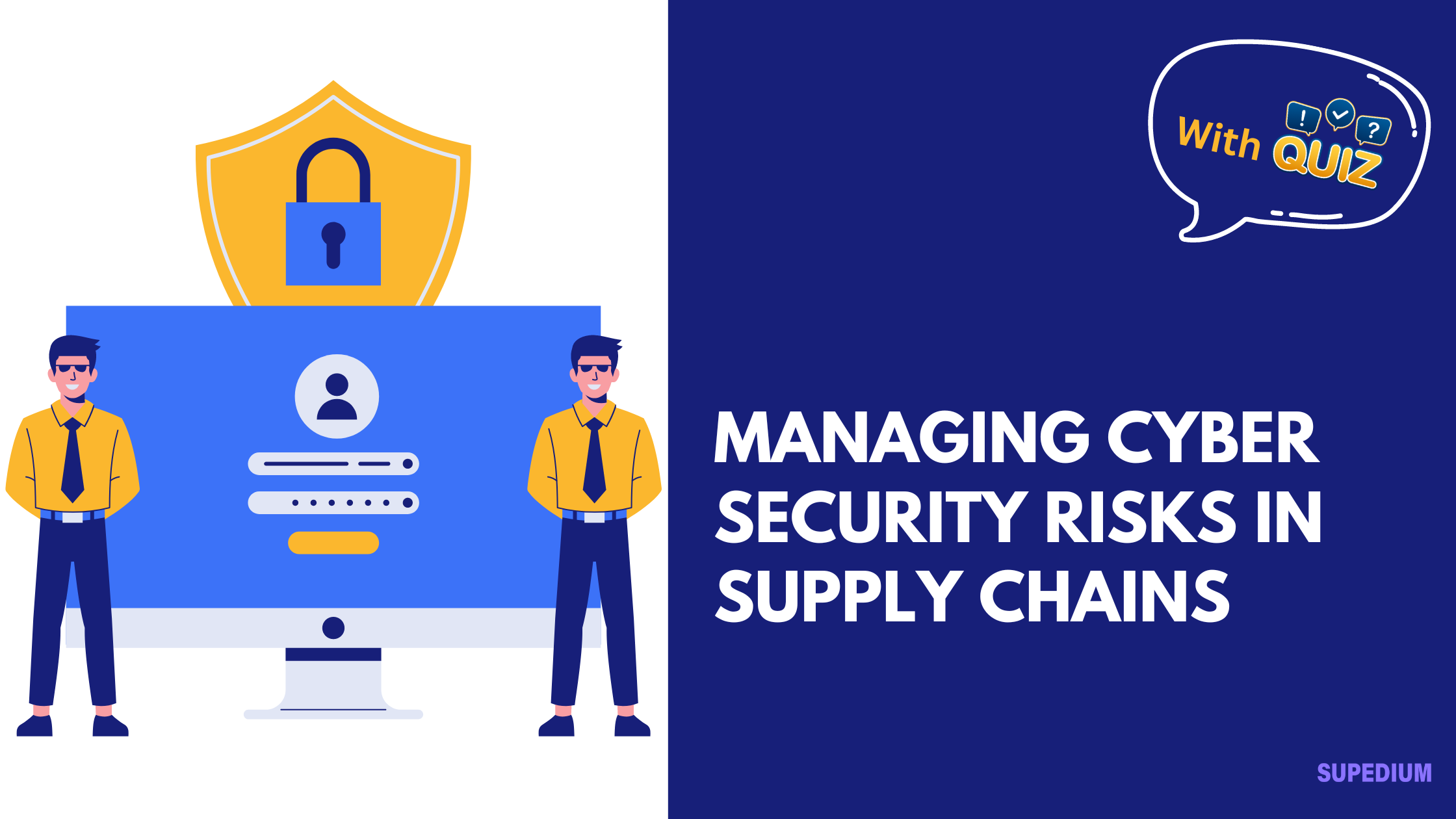Table of Contents
- 0.0.1 I. Introduction
- 0.0.2 II. Understanding Cyber Security Risks in Supply Chains
- 0.0.3 III. Risk Identification and Assessment
- 0.0.4 IV. Risk Mitigation Strategies
- 0.0.5 V. Compliance and Regulatory Considerations
- 0.0.6 VI. Emerging Trends and Future Directions
- 0.0.7 VII. Case Studies and Real-World Examples
- 0.0.8 VIII. Conclusion
- 1 Quiz Time
![]()
I. Introduction
In today’s interconnected world, supply chains are increasingly complex, involving a web of suppliers, manufacturers, distributors, and other partners. This complexity introduces significant cyber security risks, as each link in the chain represents a potential vulnerability. Understanding and managing these risks is crucial for maintaining the integrity, confidentiality, and availability of information and systems throughout the supply chain.
Relevance of Cyber Security Risks
Cyber security threats targeting supply chains have become more prevalent and sophisticated. High-profile attacks, such as the SolarWinds hack and the Target data breach, highlight the potential impact of cyber threats on global supply chains. These incidents underscore the necessity for robust cyber security measures to protect against various types of attacks that can disrupt operations, compromise data, and cause financial and reputational damage.
Purpose and Scope
This article aims to provide a comprehensive overview of managing cyber security risks within supply chains. It will cover risk identification, assessment, and mitigation strategies, as well as compliance and emerging trends in the field. By understanding and addressing these risks, organizations can enhance their resilience and protect their operations from cyber threats.
II. Understanding Cyber Security Risks in Supply Chains
Types of Cyber Security Risks
Supply chains face numerous cyber security risks, including:
- Data Breaches and Theft: Unauthorized access to sensitive data can result in significant financial losses and damage to an organization’s reputation.
- Ransomware Attacks: Cyber criminals may deploy ransomware to encrypt critical data, demanding a ransom for decryption keys.
- Insider Threats: Malicious or negligent actions by employees or contractors can lead to data leaks or system breaches.
- Supply Chain Attacks: Cyber attackers may compromise hardware or software components, embedding malicious code that can affect all downstream users.
Sources of Risks
The sources of cyber security risks in supply chains are diverse:
- Third-Party Vendors and Suppliers: Vendors with inadequate security measures can introduce vulnerabilities into an organization’s systems.
- Legacy Systems and Outdated Technologies: Older systems may lack necessary security updates and patches, making them susceptible to attacks.
- Inadequate Security Practices: Insufficient security protocols and practices within the supply chain can leave systems exposed to threats.
Impact of Cyber Attacks
Cyber attacks on supply chains can have severe consequences:
- Financial Losses: Costs associated with data breaches, operational disruptions, and ransom payments can be substantial.
- Reputational Damage: Loss of customer trust and damage to the brand’s reputation can have long-lasting effects.
- Operational Disruptions: Interruptions in supply chain operations can affect product availability and service delivery.
III. Risk Identification and Assessment
Risk Identification
Effective risk management begins with identifying potential risks within the supply chain:
- Mapping the Supply Chain: Understanding the complete network of internal and external components helps in pinpointing potential risk areas.
- Identifying Threat Vectors: Assessing where and how attacks might occur, whether through suppliers, technology, or processes, is essential.
- Assessing Vendor and Partner Risk Profiles: Evaluating the security practices and vulnerabilities of vendors and partners helps in identifying potential risks.
Risk Assessment
Once risks are identified, assessing their impact and likelihood is crucial:
- Conducting Vulnerability Assessments: Regular assessments help identify weaknesses and potential entry points for attackers.
- Evaluating Impact and Likelihood: Analyzing how likely a threat is to occur and its potential impact helps prioritize risks.
- Prioritizing Risks: Focus on risks that have the highest potential impact and probability, allowing for targeted mitigation efforts.
Tools and Techniques
Several tools and frameworks can aid in risk assessment:
- Cyber Risk Assessment Frameworks: Frameworks such as NIST and ISO/IEC 27001 provide structured approaches to assessing and managing cyber risks.
- Risk Assessment Tools and Technologies: Technologies like Security Information and Event Management (SIEM) systems and threat intelligence platforms offer valuable insights into potential threats and vulnerabilities.
IV. Risk Mitigation Strategies
Developing a Cyber Security Framework
A well-defined cyber security framework provides a structured approach to managing risks:
- Establishing Policies and Procedures: Documenting security policies and procedures ensures consistent practices across the organization.
- Defining Roles and Responsibilities: Clearly defining roles and responsibilities helps ensure accountability and effective risk management.
Vendor Management
Managing risks associated with third-party vendors is critical:
- Conducting Due Diligence: Thoroughly evaluating vendors before engagement helps identify potential security weaknesses.
- Implementing Risk Management Programs: Establishing formal risk management programs for vendors ensures ongoing monitoring and compliance.
- Setting Security Requirements: Defining and enforcing security requirements for vendors helps mitigate potential risks.
Implementing Security Controls
Security controls are essential for protecting systems and data:
- Network Security Measures: Implementing firewalls, intrusion detection systems, and other network security measures helps protect against unauthorized access.
- Data Protection Strategies: Techniques such as encryption and data masking safeguard sensitive information.
- Access Controls and Authentication: Strong access controls and authentication mechanisms ensure that only authorized individuals can access critical systems and data.
Incident Response Planning
An effective incident response plan is crucial for managing and mitigating the impact of cyber incidents:
- Developing and Testing Plans: Creating and regularly testing incident response plans ensures preparedness for potential attacks.
- Establishing Communication Protocols: Clear communication protocols and escalation procedures help manage incidents efficiently.
- Conducting Regular Drills: Regular drills and simulations test the effectiveness of response plans and identify areas for improvement.
V. Compliance and Regulatory Considerations
Relevant Regulations and Standards
Compliance with regulations and standards is a key aspect of managing cyber security risks:
- Industry-Specific Regulations: Regulations such as GDPR (General Data Protection Regulation), HIPAA (Health Insurance Portability and Accountability Act), and CCPA (California Consumer Privacy Act) impose specific requirements on data protection.
- International Standards: Standards like ISO/IEC 27001 and the NIST Cybersecurity Framework provide guidelines for establishing and maintaining cyber security practices.
Compliance Requirements
Meeting compliance requirements involves:
- Reporting Obligations: Ensuring timely and accurate reporting of cyber incidents as required by regulations.
- Documentation and Auditing: Maintaining comprehensive documentation and undergoing regular audits to verify compliance.
Best Practices for Compliance
To stay compliant:
- Staying Updated with Regulations: Keeping abreast of changes in regulations and standards is essential for ongoing compliance.
- Integrating Compliance into Strategy: Incorporating compliance requirements into the overall cyber security strategy ensures alignment and effectiveness.
VI. Emerging Trends and Future Directions
Advancements in Technology
Technological advancements are shaping the future of cyber security:
- AI and Machine Learning: AI and machine learning enhance threat detection and response capabilities by analyzing large volumes of data and identifying patterns.
- Blockchain: Blockchain technology offers potential benefits for enhancing supply chain security by providing immutable and transparent records.
Evolving Threat Landscape
The threat landscape is continuously evolving:
- Emerging Threats: New threats and attack vectors require ongoing vigilance and adaptation.
- Adapting Strategies: Organizations must continuously adapt their cyber security strategies to address emerging threats and challenges.
Collaboration and Information Sharing
Collaboration and information sharing are critical for improving cyber security:
- Industry Collaboration: Sharing threat intelligence and best practices within the industry helps strengthen collective defense.
- Threat Intelligence Platforms: Platforms for sharing information about threats and vulnerabilities enhance situational awareness and response capabilities.
VII. Case Studies and Real-World Examples
Detailed Analysis of Notable Cyber Attacks
Examining high-profile cyber attacks provides valuable insights:
- SolarWinds Hack: The SolarWinds attack demonstrated the potential impact of supply chain attacks and highlighted the need for robust monitoring and response mechanisms.
- Target Data Breach: The Target breach illustrated the risks associated with vendor management and the importance of securing third-party access.
Successful Risk Management Strategies
Analyzing successful strategies offers practical guidance:
- Effective Practices: Organizations that effectively managed cyber risks often implemented comprehensive security frameworks, conducted thorough risk assessments, and maintained strong vendor management practices.
- Key Takeaways: Lessons learned from successful risk management include the importance of proactive measures, continuous monitoring, and a robust incident response plan.
VIII. Conclusion
Summary of Key Points
Managing cyber security risks in supply chains involves identifying potential threats, assessing their impact, and implementing effective mitigation strategies. Establishing a comprehensive cyber security framework, managing vendor risks, and adhering to compliance requirements are crucial for protecting supply chains from cyber threats.
Future Outlook
The future of cyber security in supply chains will be shaped by advancements in technology, evolving threats, and increased collaboration. Organizations must remain vigilant and adaptable to stay ahead of emerging risks and challenges.






Be the first to comment